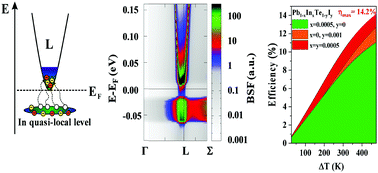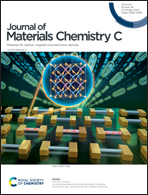Highly efficient n-type PbTe developed by advanced electronic structure engineering†
Abstract
Lead telluride is one of the most attractive state-of-the-art thermoelectric (TE) materials. Therefore, any improvement of its average thermoelectric figure of merit (ZT)av over a broad temperature range is a great challenge. Here, we show that advanced electronic structure engineering using the In quasi-local level with simultaneously optimized EF leads to a significant enhancement of energy conversion. Electronic structure calculations confirmed the formation of a half-occupied indium quasi-local level in PbTe, which, together with I-implemented electrons, provides the optimal chemical potential in terms of energy conversion, near the conduction band edge over the entire temperature range. As a result, an extremely high average thermoelectric figure of merit (ZT)av of up to ∼1.05 in the temperature range of 298 K to 773 K was achieved. Thermoelectric efficiency η was enhanced up to 14.2% for an n-type PbTe-based leg, which is one of the record-high values for a single-phase TE material. The performed theoretical analyses and experimental data prove that the large (ZT)av found in our system comes from the electronic structure and chemical potential engineering, offering a novel route for improving the efficiency of thermoelectric devices.



 Please wait while we load your content...
Please wait while we load your content...